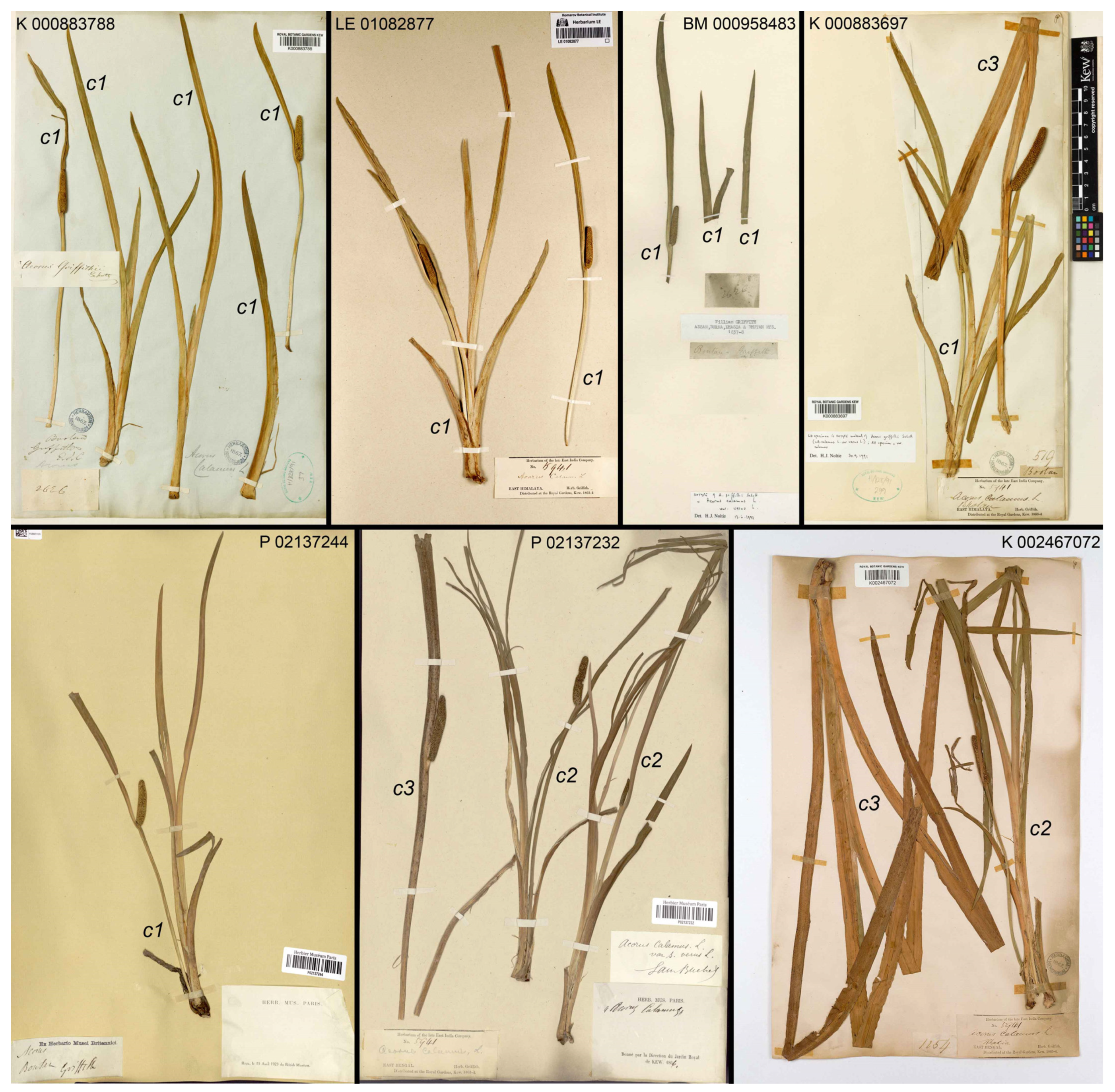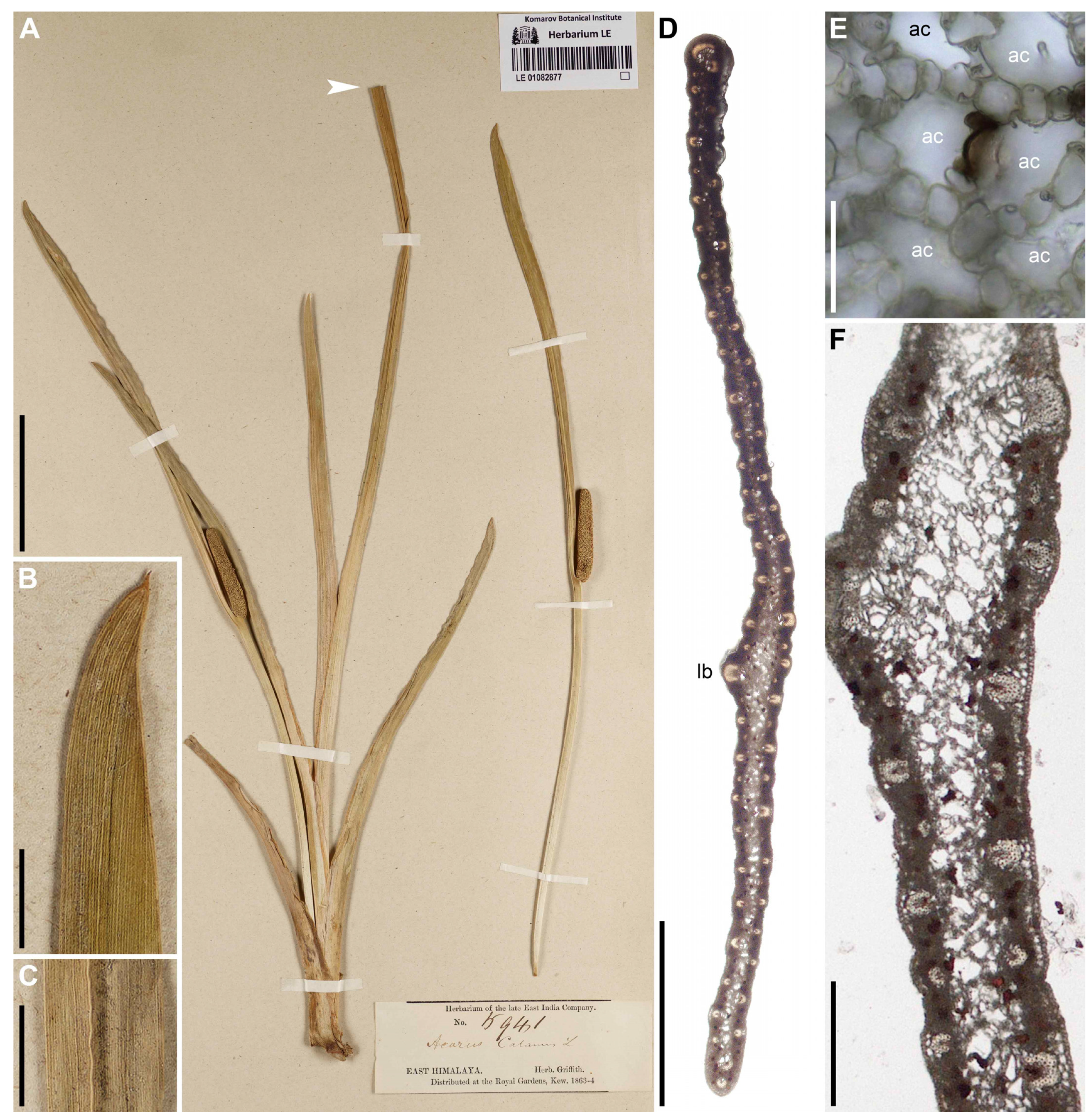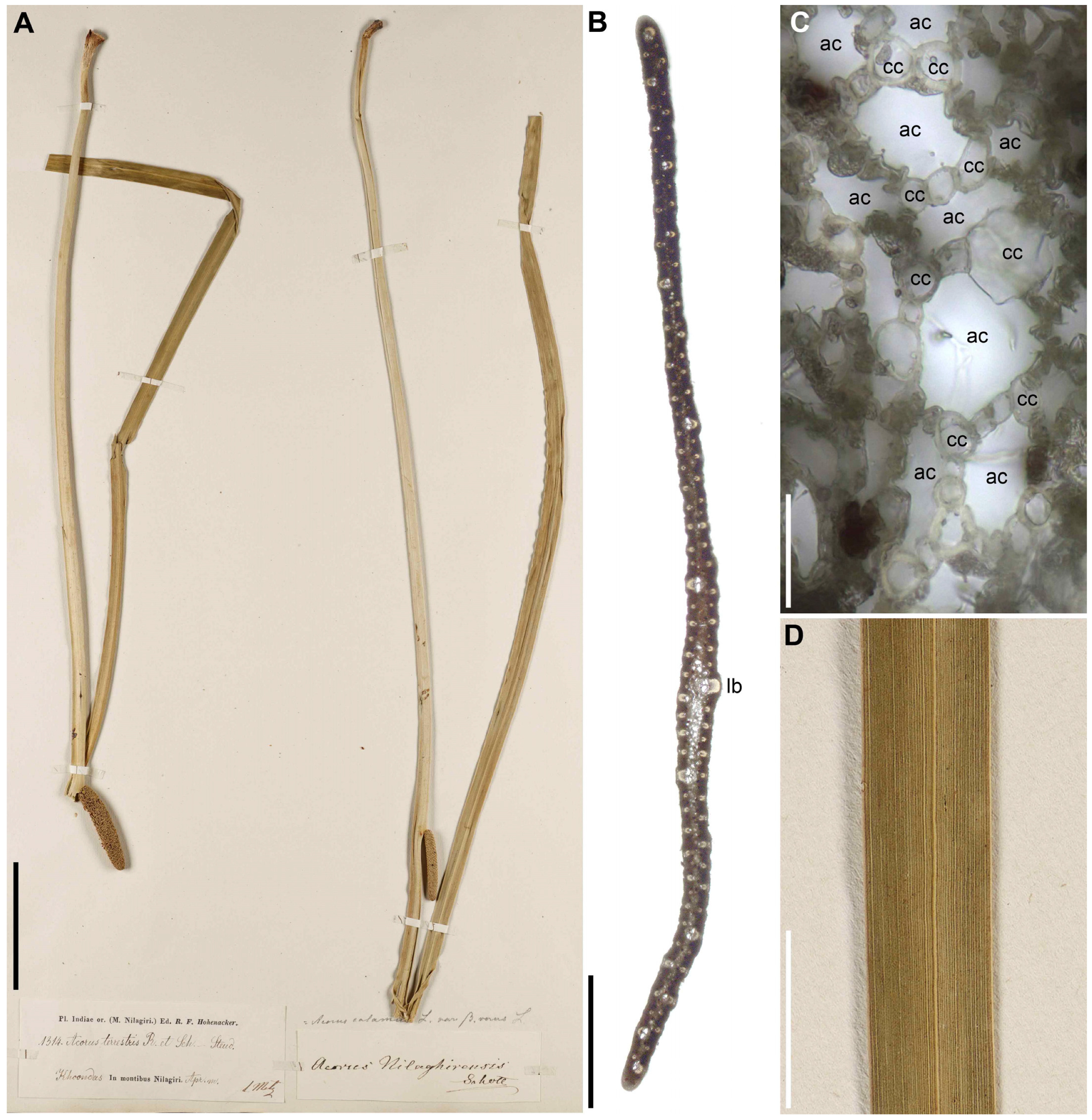Inference of Ploidy Level in 19th-Century Historical Herbarium Specimens Reveals the Identity of Five Acorus Species Described by Schott
Abstract
1. Introduction
2. Materials and Methods
2.1. Nomenclatural Analysis
2.2. Ploidy Level
3. Results and Discussion
3.1. Acorus triqueter Is a Diploid from Siberia
3.2. Acorus tatarinowii Is a Tetraploid from N China
3.3. Acorus griffithii Is a Tetraploid from Bhutan
3.4. Acorus commutatus Is Another Name for A. griffithii
3.5. Acorus nilaghirensis Is a Tetraploid from the Peninsular India
4. Conclusions
Author Contributions
Funding
Institutional Review Board Statement
Data Availability Statement
Acknowledgments
Conflicts of Interest
References
- Schott, H.W. Aroideen-Skizzen. Oesterr. Bot. Z. 1858, 8, 349–351. [Google Scholar] [CrossRef]
- Schott, H.W. Aroideen-Skizzen. Oesterr. Bot. Z. 1859, 9, 98–101. [Google Scholar] [CrossRef]
- Schott, H.G. Prodromus Systematis Aroidearum; Typis Congregationis Mechitharisticae: Vienna, Austria, 1860. [Google Scholar]
- Schott, H.G.; Araceae, H.W. Pars altera. Nova genera et species, adiectis quibusdam adnotationibus. Ann. Mus. Bot. Lugduno-Batavi 1864, 1, 278–286. [Google Scholar]
- Duvall, M.L.; Learn, G.H., Jr.; Eguiarte, L.E.; Clegg, M.T. Phylogenetic analysis of rbcL sequences identifies Acorus calamus as the primal extant monocotyledon. Proc. Natl. Acad. Sci. USA 1993, 90, 4641–4644. [Google Scholar] [CrossRef]
- Bogner, J.; Mayo, S.J. Acoraceae. In The Families and Genera of Vascular Plants; Kubitzki, K., Ed.; Springer: Berlin, Germany, 1998; Volume 4, pp. 7–11. [Google Scholar]
- The Angiosperm Phylogeny Group; Chase, M.W.; Christenhusz, M.J.M.; Fay, M.F.; Byng, J.W.; Judd, W.S.; Soltis, D.E.; Mabberley, D.J.; Sennikov, A.N.; Soltis, P.S.; et al. An update of the Angiosperm Phylogeny Group classification for the orders and families of flowering plants: APG IV. Bot. J. Linn. Soc. 2016, 181, 1–20. [Google Scholar] [CrossRef]
- Engler, A. Araceae. In Monographiae Phanerogamarum Prodromi Nunc Continuatio, Nunc Revisio; Candolle, A., de Candolle, C., Eds.; G. Masson: Paris, France, 1879; Volume 2. [Google Scholar]
- Engler, A. Araceae-Pothoideae. In Das Pflanzenreich, 21 (IV. 23B); Engler, A., Ed.; Engelmann: Leipzig, Germany, 1905; pp. 1–330. [Google Scholar]
- Röst, L.C.M. Biosystematic investigations with Acorus L. 4. Communication. A synthetic approach to the classification of the genus. Planta Med. 1979, 37, 289–307. [Google Scholar] [CrossRef]
- Li, H.; Zhu, G.; Bogner, J. Acoraceae. In Flora of China; Wu, Z., Raven, P., Eds.; Science Press: Beijing, China; Missouri Botanical Garden Press: St. Louis, MI, USA, 2010; Volume 2, pp. 1–2. [Google Scholar]
- Bogner, J. Acoraceae. In Flora Malesiana, 1st ed.; Noteboom, H.P., Ed.; Nationaal Herbarium Nederland: Leiden, The Netherlands, 2011; Volume 20, pp. 1–13. [Google Scholar]
- Boyce, P. Acoraceae. In Flora of Thailand; Santisuk, T., Larsen, K., Eds.; The Forest Herbarium, Department of National Parks, Wildlife and Plant Conservation: Bangkok, Thailand, 2012; Volume 11, pp. 322–325. [Google Scholar]
- Murata, J. Acoraceae. In Flora of Japan; Iwatsuki, K., Boufford, D.E., Ohba, H., Eds.; Kodansha: Tokyo, Japan, 2016; Volume IVb, p. 5. [Google Scholar]
- Linnaeus, C. Species Plantarum; L. Salvius: Holmia, Sweden, 1753. [Google Scholar]
- Aiton, W. Hortus Kewensis, or a Catalogue of the Plants Cultivated in the Royal Botanic Garden at Kew; George Nicol: London, UK, 1789; Volume 1. [Google Scholar]
- Löve, Á.; Löve, D. Drug content and polyploidy in Acorus. Proc. Genet. Soc. Can. 1957, 2, 14–17. [Google Scholar]
- Packer, J.G.; Ringius, G.S. The distribution and status of Acorus (Araceae) in Canada. Can. J. Bot. 1984, 62, 2248–2252. [Google Scholar] [CrossRef]
- Löve, Á.; Löve, D.; Löve, Á. Chromosome Number Reports LXXXIX. Taxon 1985, 34, 729–730. [Google Scholar] [CrossRef]
- Petersen, G. Cytology and systematics of Araceae. Nord. J. Bot. 1989, 9, 119–166. [Google Scholar] [CrossRef]
- Thompson, S.A. Systematics and Biology of the Araceae and Acoraceae of Temperate North America. Ph.D. Thesis, University of Illinois at Urbana-Champaign, Urbana, IL, USA, 1995. [Google Scholar]
- Thompson, S.A. Acoraceae. In Flora of North America North of Mexico; Magnoliophyta: Alismatidae, Arecidae, Commelinidae (In Part), and Zingiberidae. Flora of North America Editorial Committee, Ed.; Oxford University Press: New York, NY, USA, 2000; Volume 22, pp. 124–127. [Google Scholar]
- Larsen, K. Cytology of vascular plants III. A study of Thai aroids. Dansk Bot. Ark. 1969, 27, 39–59. [Google Scholar]
- Li, H. Acorus. In Flora Reipublicae Popularis Sinicae; Wu, C., Li, H., Eds.; Science Press: Beijing, China, 1979; Volume 13, pp. 4–9. (In Chinese) [Google Scholar]
- Wei, F.N.; Li, Y.K. A new spice, Acorus macrospadiceus from south China. Guihaia 1985, 5, 179–182. (In Chinese) [Google Scholar]
- Zhu, Z. Some new taxa of Acorus (Araceae) from Sichuan. Acta Bot. Bor.-Occ. Sinica 1985, 5, 118–121. (In Chinese) [Google Scholar]
- Ho, P.H. An Illustrated Flora of Vietnam; Nha Xuat Ban Tre: Ho Chi Minh, Vietnam, 2000; Volume 3, pp. 1–1020. (In Vietnamese) [Google Scholar]
- Zhang, W. Pharmacognostic Study of Acorus—From a Phylogenetic Perspective. Ph.D. Thesis, Hong Kong Baptist University, Hong Kong, China, 2005. [Google Scholar]
- Shu, H.; Zhang, S.; Lei, Q.; Zhou, J.; Ji, Y.; Luo, B.; Hong, L.; Li, F.; Liu, B.; Long, C. Ethnobotany of Acorus in China. Acta Soc. Bot. Polon. 2018, 87, 3585. [Google Scholar] [CrossRef]
- Cheng, Z.; Shu, H.; Zhang, S.; Luo, B.; Gu, R.; Zhang, R.; Ji, Y.; Li, F.; Long, C. From folk taxonomy to species confirmation of Acorus (Acoraceae): Evidences based on phylogenetic and metabolomic analyses. Front. Plant Sci. 2020, 11, 965. [Google Scholar] [CrossRef]
- Sokoloff, D.D.; Remizowa, M.V.; Nuraliev, M.S.; Averyanov, L.V.; Sennikov, A.N. The first genome from the basal monocot family has been misnamed: Taxonomic identity of Acorus tatarinowii (Acoraceae), a source of numerous chemical compounds of pharmaceutical importance. Diversity 2023, 15, 176. [Google Scholar] [CrossRef]
- Wulff, H.D. Zur Zytologie, geographischen Verbreitung und Morphologie des Kalmus. Arch. Pharm. 1954, 287, 529–541. [Google Scholar] [CrossRef]
- POWO. Plants of the World Online. Facilitated by the Royal Botanic Gardens, Kew. 2023. Available online: http://www.plantsoftheworldonline.org/ (accessed on 29 March 2023).
- Turland, N.J.; Wiersema, J.H.; Barrie, F.R.; Greuter, W.; Hawksworth, D.L.; Herendeen, P.S.; Knapp, S.; Kusber, W.-H.; Li, D.-Z.; Marhold, K.; et al. (Eds.) International Code of Nomenclature for Algae, Fungi, and Plants (Shenzhen Code). In Proceedings of the Adopted by the Nineteenth International Botanical Congress, Shenzhen, China, 23–29 July 2017; Koeltz Botanical Books: Glashütten, Germany, 2018. [Google Scholar] [CrossRef]
- Wulff, H.D. Über die Ursache der Sterilität des Kalmus (Acorus calamus L). Planta 1940, 31, 478–491. [Google Scholar] [CrossRef]
- Sokoloff, D.D.; Skaptsov, M.V.; Vislobokov, N.A.; Smirnov, S.V.; Shmakov, A.I.; Remizowa, M.V. Morphological characterization of diploid and triploid Acorus calamus (Acoraceae) from southern Western Siberia, parthenocarpy in sterile plants and occurrence of aneuploidy. Bot. J. Linn. Soc. 2021, 195, 189–215. [Google Scholar] [CrossRef]
- Sokoloff, D.D.; Remizowa, M.V.; Skaptsov, M.V.; Yadav, S.R.; Sennikov, A.N. Back to Linnaeus: Proper botanical naming of the tetraploid Indian Acorus (Acoraceae), an important medicinal plant. Diversity. submitted.
- Shi, T.; Huneau, C.; Zhang, Y.; Li, Y.; Chen, J.; Salse, J.; Wang, Q. The slow-evolving Acorus tatarinowii genome sheds light on ancestral monocot evolution. Nat. Plants 2022, 8, 764–777. [Google Scholar] [CrossRef]
- Wulff, H.D. Der Ölgehalt verschiedenchromosomiger Rassen vom Kalmus (Acorus Calamus L.). Zeitschr. Naturforsch. A 1946, 1, 600–603. [Google Scholar] [CrossRef]
- Wulff, H.D. Ölgehalt und Chromosomenzahl des nordamerikanischen Kalmus (Acorus calamus L.). Arch. Pharm. 1950, 283, 155–161. [Google Scholar] [CrossRef]
- Röst, L.C.M.; Bos, R. Biosystematic investigations with Acorus L. 3. Communication. Constituents of essential oils. Planta Med. 1979, 36, 350–361. [Google Scholar] [CrossRef]
- Mittal, N.; Varshney, V.K.; Song, B.H.; Ginwal, H.S. High levels of diversity in the phytochemistry, ploidy and genetics of the medicinal plant Acorus calamus L. Med. Aromat. Plants 2015, S1, 002. [Google Scholar] [CrossRef]
- Ahlawat, A.; Katoch, M.; Rama, G.; Ahuja, A. Genetic diversity in Acorus calamus L. as revealed by RAPD markers and its relationship with β-asarone content and ploidy level. Sci. Hortic. 2010, 124, 294–297. [Google Scholar] [CrossRef]
- Röst, L.C.M. Biosystematic investigations with Acorus L. (Araceae). 1. Communication. Cytotaxonomy. Proc. K Ned. Akad. Wet. 1978, 81, 428–441. [Google Scholar]
- Turczaninow, N. Flora Baicalensi-Dahurica seu Descriptio plantarum in regionibus cis- et transbaicalensibus atque in Dahuria sponte nascentium. Bull. Soc. Imp. Nat. Moscou 1854, 27, 53–130. [Google Scholar]
- Borodin, I. Collectors and Collections in the Flora of Siberia; Imperial Academy of Sciences: Saint-Petersburg, Russia, 1908. (In Russian) [Google Scholar]
- Mücke, M. Über den Bau und die Entwicklung der Früchte und über die Herkunft von Acorus calamus L. Bot. Zeit. 1908, 66, 1–23. [Google Scholar]
- Vinogradova, Y.K. Variability of Acorus calamus L. biological characteristics in natural and invasive populations. Byull. Glavn. Bot. Sada 2004, 187, 23–31. (In Russian) [Google Scholar]
- Chepinoga, V.V.; Gnutikov, A.A.; Enushchenko, I.V.; Chepinoga, A.V. Acorus calamus. In:Marhold, K., Ed. IAPT/IOPB Chromosome Data 6. Taxon 2008, 57, 1267, E1. [Google Scholar] [CrossRef]
- Krivenko, D.A.; Kotseruba, V.V.; Kazanovsky, S.G.; Verkhozina, A.V.; Chernova, O.D. Acorus calamus. In: Marhold, K., Ed IAPT/IOPB chromosome data 16. Taxon 2013, 62, 1357, E4. [Google Scholar]
- Probatova, N.S.; Gnutikov, A.A.; Rudyka, E.G.; Chepinoga, V.V. Chromosome numbers of some plant species from Baikal Siberia. Bot. Zhurn. 2008, 93, 162–181. [Google Scholar]
- Chepinoga, V.V. Chromosome Numbers of Plant Species from Baikal Siberia; Nauka: Novosibirsk, Russia, 2014. [Google Scholar]
- de Loureiro, J. Flora Cochinchinensis: Sistens Plantas in Regno Cochinchina Nascentes. Quibus Accedunt Aliæ Observatæ in Sinensi Imperio, Africa Orientali, Indiæque Locis Variis. Omnes Dispositæ Secundum Systema Sexuale Linnæanum; Ulyssipone: Lisboa, Portugal, 1790. [Google Scholar]
- Hooker, J.D. Works of the late William Griffith, Esq. F. L. S. & C. Posthumous papers, bequeathed to the Hon. East India Company, and printed by the order of the Government of Bengal. Lond. J. Bot. 1848, 7, 446–449. [Google Scholar]
- Hooker, J.D. Catalogue of the Plants Distributed at the Royal Gardens, Kew, under the Sanction of the Secretary of State for India, from the Herbaria of Griffith, Falconer, and Helfer; J.E. Taylor: London, UK, 1865. [Google Scholar]
- Lang, W.H. William Griffith, 1810–1845. In Makers of British Botany: A Collection of Biographies by Living Botanists; Oliver, F.W., Ed.; Cambridge University Press: Cambridge, UK, 1913; pp. 178–191. [Google Scholar]
- Huxley, L. (Ed.) Life and Letters of Sir Joseph Dalton Hooker; J. Murray: London, UK, 1918; Volume 1. [Google Scholar]
- Griffith, W. Itinerary Notes of Plants Collected in the Khasyah and Bootan Mountains, 1837–1838, in Affghanisthan and Neighbouring Countries, 1839 to 1841; J.F. Bellamy: Calcutta, UK, 1848. [Google Scholar]
- Griffith, W. Journals of Travels in Assam, Burma, Bootan, Affghanistan and the Neighbouring Countries; Bishop’s College Press: Calcutta, UK, 1847. [Google Scholar]
- Hooker, J.D.; Thomson, T. Introductory Essay to the Flora Indica; W. Pamplin: London, UK, 1855. [Google Scholar]
- Anonymous. Intended distribution of the Herbaria of the East India Company. Bot. Gaz. 1849, 1, 112. [Google Scholar]
- Noltie, H.J. Flora of Bhutan Including a Record of Plants from Sikkim and Darjeeling; Royal Botanic Garden Edinburgh: Edinburgh, UK, 1994; Volume 3. [Google Scholar]
- Ogra, R.K.; Mohanpuria, P.; Sharma, U.K.; Sharma, M.; Sinha, A.K.; Ahuja, P.S. Indian calamus (Acorus calamus L.): Not a tetraploid. Curr. Sci. 2009, 97, 1644–1647. [Google Scholar]
- Griffith, W. Icones Plantarum Asiaticarum; C.A. Serrao: Calcutta, UK, 1851; Volume 3. [Google Scholar]
- Griffith, W. Notulae ad Plantas Asiaticas; C.A. Serrao: Calcutta, UK, 1851; Volume 3. [Google Scholar]
- Bliss, E.M. (Ed.) The Encyclopaedia of Missions; Funk & Wagnalls: New York, NY, USA, 1891; Volume 1. [Google Scholar]
- Stewart, R.R. Missionaries and clergymen as botanists in India and Pakistan. Taxon 1982, 31, 57–64. [Google Scholar] [CrossRef]
- Fürnrohr, A.E. Getrocknete Pflanzensammlungen: Plantarum Indiae orientalis Sect. V. Flora 1854, 37, 187–189. [Google Scholar]
- Hohenacker, R.F. Verkäufiche Pflanzensammlungen. Oesterr. Bot. Z. 1859, 9, 1–4. [Google Scholar]
- Wörz, A. Der Esslinger Botanische Reiseverein 1825–1845: Eine Aktiengesellschaft zur Durchführung Naturkundlicher Sammelreisen; Logos Verlag: Berlin, Germany, 2016. [Google Scholar]
- Hohenacker, R.F. Anzeige: Sammlungen ostindischer Pflanzen aus Canara und den Nilgherries. Flora 1851, 34, 718–720. [Google Scholar]
- Hohenacker, R.F. (Ed.) Plantarum Indiae orientalis Sect. V. Cura Rev. Fr. Metz, Missionarii Evangelicae Societatis Basileensis, Pro Maximu Parte in Montibus Nilagiri Collectas, a DD. Bentham, Fenzl, Hochstetter, Meisner, Miquel, de Schlechtendal, C.H. Schultz Bip., Steudel aliisque Examinatas Edidit R.F. Hohenacker; Esslinger Botanische Reiseverein: Esslingen, Kingdom of Württemberg, 1853. [Google Scholar]
- British Museum. The History of the Collections Contained in the Natural History Departments of the British Museum; Trustees of the British Museum: London, UK, 1904; Volume 1. [Google Scholar]
- Lipsky, V.I. Herbarium. In Historical Account of the Imperial Botanical Garden in Saint-Petersburg for 1873–1898; Fischer von Waldheim, A.A., Ed.; Imperial Botanical Garden: Saint-Petersburg, Russia, 1899; pp. 36–160. (In Russian) [Google Scholar]
- Hohenacker, R.F. Anzeigen: Getrocknete Pflanzen aus Klein-Asien, Sibirien und Ost-Indien. Flora 1847, 30, 622. [Google Scholar]
- Riedl, H. Heinrich Wilhelm Schott (1794–1865). Taxon 1965, 14, 209–213. [Google Scholar] [CrossRef]
- Wang, H.; Li, W.L.; Gu, Z.J.; Chen, Y.Y. Cytological study on Acorus L. in southwestern China, with some cytogeographical notes on A. calamus. Acta Bot. Sinica 2001, 43, 354–358. [Google Scholar]







| Specimen ID | Schott’s Species Name | Nomencla- Tural Status | Number of Staining/Nonstaining Pollen Grains Counted (% of Fertile) | Fruits with Seeds | Number of air Canals Per 0.62 mm2 of the Cross Section of Leaf Blade (Mean of Two Fields of View) | Mean Cell Number in 20 Septa in Cross Section (Corner Cells not Counted) | Inferred Ploidy Level |
|---|---|---|---|---|---|---|---|
| LE 01082852 | A. triqueter | lectotype | n/a | present | 9.75 | 5.4 | diploid |
| LE 01082856 | A. triqueter | isolectotype | n/a | present | 22.5 | 4.5 | diploid |
| LE 01182327 | A. tatarinowii | isotype | 101/3 (97%) | absent | 107.25 | 1.6 | tetraploid |
| LE 01182325 | A. tatarinowii | isotype | 112/1 (99%) | absent | 134.5 | 1.9 | tetraploid |
| LE 01082877 | A. griffithii | isotype | 50/1 (98%) | absent | n/a | 1.2 | tetraploid |
| LE 01082855 | A. nilaghirensis | isolectotype | 14/1 (93%) | absent | n/a | 1.2 | tetraploid |
| Herbarium Collection (See Labels in Figure 4) | c1 | c2 | c3 |
|---|---|---|---|
| Griffith’s collection number | 519 | 1254 | 1254 |
| E.I.C. distribution number | 2626 | no distribution | no distribution |
| Kew distribution number | 5941 | 5941 | 5941 |
| herbarium specimens | K 000883788, K 000883697 (pro parte), BM 000958483, LE 01082877, P 02137244 | K 002467072 (pro parte), P 02137232 (pro parte) | K 000883697 (pro parte), K 002467072 (pro parte), P 02137232 (pro parte) |
| collection date | 1–4 February 1838 | 15–21 September 1837 | 12 November 1837 |
| present-day country | Bhutan | Bangladesh | India |
| locality as printed on distribution labels | East Himalaya | East Bengal | East Bengal |
| locality as written on distribution labels | Bhotan | Khasia | Khasia |
| locality as in Griffith’s travel diaries | Benka | Sylhet | Nurtung |
| locality in present-day terminology | Tashigang District: Tashigang Town | Sylhet Division: from Habiganj Town to Surma River west of Chhatak Town | Meghalaya State: West Jaintia Hills District, Nartiang Town |
| estimated coordinates | 27.339° N, 91.547° E | between 24.4° N, 91.4° E and 25° N, 91.62° E | 25.566° N, 92.21° E |
| estimated elevation | 700 m | 50 m | 1200 m |
| phenological phase | male stage of anthesis | postanthetic | postanthetic (one inflorescence abortive?) |
| characteristic features | plants less than 40 cm tall, leaves less than 1 cm wide, young leaves present, spadix < 5 cm long | plants c. 50 cm tall, leaves less than 1 cm wide, distal parts of leaves longitudinally split during herborization, young leaves absent, spadix < 5 cm long | plants >70 cm tall, leaves more than 1 cm wide, foliage appears to be senescent, spadix > 5 cm long |
| inferred ploidy level | tetraploid | pending destructive sampling | pending destructive sampling |
| nomenclatural status | type collection of Acorus griffithii | no type status | no type status |
Disclaimer/Publisher’s Note: The statements, opinions and data contained in all publications are solely those of the individual author(s) and contributor(s) and not of MDPI and/or the editor(s). MDPI and/or the editor(s) disclaim responsibility for any injury to people or property resulting from any ideas, methods, instructions or products referred to in the content. |
© 2023 by the authors. Licensee MDPI, Basel, Switzerland. This article is an open access article distributed under the terms and conditions of the Creative Commons Attribution (CC BY) license (https://creativecommons.org/licenses/by/4.0/).
Share and Cite
Sokoloff, D.D.; Remizowa, M.V.; Severova, E.E.; Sennikov, A.N. Inference of Ploidy Level in 19th-Century Historical Herbarium Specimens Reveals the Identity of Five Acorus Species Described by Schott. Diversity 2023, 15, 766. https://doi.org/10.3390/d15060766
Sokoloff DD, Remizowa MV, Severova EE, Sennikov AN. Inference of Ploidy Level in 19th-Century Historical Herbarium Specimens Reveals the Identity of Five Acorus Species Described by Schott. Diversity. 2023; 15(6):766. https://doi.org/10.3390/d15060766
Chicago/Turabian StyleSokoloff, Dmitry D., Margarita V. Remizowa, Elena E. Severova, and Alexander N. Sennikov. 2023. "Inference of Ploidy Level in 19th-Century Historical Herbarium Specimens Reveals the Identity of Five Acorus Species Described by Schott" Diversity 15, no. 6: 766. https://doi.org/10.3390/d15060766
APA StyleSokoloff, D. D., Remizowa, M. V., Severova, E. E., & Sennikov, A. N. (2023). Inference of Ploidy Level in 19th-Century Historical Herbarium Specimens Reveals the Identity of Five Acorus Species Described by Schott. Diversity, 15(6), 766. https://doi.org/10.3390/d15060766









